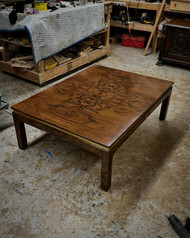Maintaining and caring for wood veneer furniture properly can extend its lifespan and keep it looking beautiful. Here are some expert tips to help you protect and preserve your wood veneer furniture:
1. Regular Dusting
- Use a Soft Cloth: Dust your wood veneer furniture regularly with a soft, dry cloth (like microfiber) to prevent dust buildup. Dust can scratch the veneer if not cleaned properly.
- Avoid Abrasive Materials: Never use abrasive cloths or rough materials that might scratch the surface.
2. Clean Spills Immediately
- Blot, Don’t Rub: In case of spills, blot the area immediately with a soft, dry cloth rather than rubbing, which could damage the veneer or push the liquid deeper into the wood.
- Use a Mild Cleaner: For stubborn stains, use a damp cloth with a mild soap solution or a specially formulated wood cleaner. Always avoid soaking the veneer surface with water.
3. Avoid Excessive Moisture
- Keep Dry: Wood veneer is susceptible to water damage. Excessive moisture can cause warping, swelling, or separation of the veneer from its substrate.
- Use Coasters and Mats: Protect your veneer furniture from spills and water rings by always using coasters under drinks and placemats under hot dishes.
- Control Humidity: If possible, maintain consistent humidity levels in the room to prevent the wood veneer from expanding and contracting, which can cause cracks or peeling.
4. Protect from Heat and Sunlight
- Avoid Direct Sunlight: Prolonged exposure to direct sunlight can cause fading or discoloration of the veneer. Place your furniture in areas where it’s shielded from harsh sunlight, or use curtains or blinds to limit sun exposure.
- Heat Protection: Always place protective pads under hot items like pots, pans, or coffee cups. High heat can damage or warp the veneer.
5. Use Furniture Polish Sparingly
- Avoid Silicone-based Polishes: Most commercial furniture polishes contain silicone, which can leave a residue that attracts dust. Instead, use polishes designed specifically for wood veneer or a natural polish made from ingredients like beeswax.
- Apply Occasionally: Polish only occasionally (once every few months), as over-polishing can cause buildup and dull the veneer’s finish.
6. Handle Scratches and Chips Carefully
- Repair Small Scratches: For light scratches, use a matching wood stain pen or touch-up marker to conceal the damage. You can also use a furniture wax stick to fill in small chips or gouges.
- Professional Refinishing for Major Damage: Deep scratches, chips, or peeling veneer might require professional refinishing. Avoid sanding or using harsh products yourself, as veneer is thin and can be easily damaged if not handled correctly.
7. Protect Edges and Corners
- Prevent Chipping: Veneer is more vulnerable to damage at the edges and corners. Be cautious when moving or bumping the furniture to avoid chips or peeling at these areas.
- Use Edge Guards: For high-traffic areas or surfaces frequently in contact with objects (like desks), use edge protectors or guards to prevent accidental damage.
8. Avoid Dragging Objects Across the Surface
- Lift, Don’t Drag: When moving items like vases, lamps, or dishes, lift them rather than dragging them across the surface. Dragging can scratch or damage the veneer’s finish.
9. Use a Tablecloth or Surface Protector
- Prevent Scratches: For frequently used tables (like dining tables or desks), consider using a tablecloth, runner, or surface protector to reduce wear and tear on the veneer.
- Rotation: If possible, rotate decorative objects regularly to avoid uneven wear and sun damage to one area of the surface.
10. Regular Inspection
- Check for Loose Veneer: Periodically inspect your furniture for any signs of veneer loosening or peeling. Catching these issues early can prevent more significant damage.
- Use Wood Glue for Minor Repairs: If you notice a small section of veneer lifting, you can use a small amount of wood glue to carefully reattach it. Press down gently with a soft cloth until the glue dries.
11. Keep Furniture Away from Extreme Temperatures
- Avoid Placement Near Heating or Cooling Sources: Keep wood veneer furniture away from direct heat sources like radiators, heaters, or air conditioning vents, which can cause the wood to dry out, crack, or warp.
12. Avoid Harsh Chemicals
- No Ammonia or Bleach: Harsh chemical cleaners like ammonia, bleach, or strong multi-purpose cleaners can damage the finish and wood underneath. Stick to products designed for wood veneer surfaces.
13. Use Veneer-friendly Cleaners
- Oil-based Cleaners: Occasionally using an oil-based cleaner can help nourish the wood veneer and enhance its natural luster, but don’t use it excessively to avoid buildup.
By following these expert tips, you can preserve the beauty and longevity of your wood veneer furniture, keeping it looking its best for years to come. Regular maintenance, proper cleaning, and protective measures go a long way in maintaining the natural charm of veneer.


